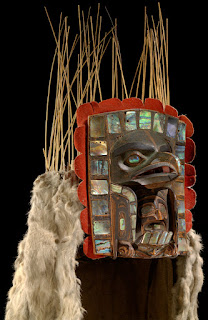Exhibition: Infinity of Nations: Art and History in the Collections of the National Museum
Dates: 23 October 2010 - 25 October 2020, 10 AM - 5 PM daily
Dates: 23 October 2010 - 25 October 2020, 10 AM - 5 PM daily
Place: National Museum of the American Indian NY, The George Gustav Heye Center , One Bowling Green , New York (US
Admission: Free
About the exhibition:
This new permanent exhibition of some 700 works of Native art from throughout North, Central, and South America demonstrates the breadth of the museum's renowned collection and highlight the historic importance of many of these iconic objects.
Chosen to illustrate the geographic and chronological scope of the museum's collection, Infinity of Nations opens with a display of headdresses. Signifying the sovereignty of Native nations, these works includes a magnificent Kayapo krok-krok-ti, a macaw-and-heron-feather ceremonial headdress.
Focal-point objects, representing each region, includes an Apsaalooke (Crow) robe illustrated with warriors' exploits; a detailed Mayan limestone bas relief depicting a ball player; an elaborately beaded Inuit tuilli, or woman's inner parka, made for the mother of a newborn baby; a Mapuche kultrung, or hand drum, depicting the cosmos; a carved and painted chief's headdress, depicting a killer whale with a raven emerging from its back, created and worn by Willie Seaweed (Kwakwaka'wakw); an anthropomorphic Shipibo joni chomo, or water vessel from Peru; a Chumash basket decorated with a Spanish-coin motif; an ancient mortar from Pueblo Bonito in Chaco Canyon, N.M.; a gourd carved with a detailed picture of the Battle of Arica by Mariano Flores Kananga (Quechua); and an early Anishinaabe man's outfit complete with headdress, leggings, shirt, sash, and jewelry. The exhibition concludes with works by Native artists including Allan Houser (Warm Springs Chiricahua Apache) and Rick Bartow (Mad River Wiyot).
The National Museum of the American Indian (NMAI) houses one of the world’s great cultural resources, with collections representing the Native peoples of the Americas George Gustav Heye Center in New York
In a departure for the museum, Infinity of Nations is organized geographically. Central to the exhibition are fifty objects highlighted within the regional sections, with brief descriptions written by an impressive new generation of Native scholars and community knowledge-keepers. Many of these iconic objects, like the Diné (Navajo) first phase chief blanket, speak to a people’s history and culture at a certain point in time. Several highlighted objects are associated with prominent Native individuals. Still others, like the pottery plate and candleholders from the mission church at the ancestral A:shiwi (Zuni) village of Hawikku
Ten singular examples serve as regional focal points. The more detailed expositions of these objects, including a magnificent Apsáalooke (Crow) warrior’s exploit robe and an impressive Maya limestone bas-relief depicting a ball player, further demonstrate the degree to which Native cultures were interconnected long before European peoples arrived in the Americas, and how Native peoples and Europeans together made more recent history.
The conclusion of Infinity of Nations looks at contemporary Native art as a medium for exploring Native experiences and ideas. Throughout, the exhibition illustrates how objects in the museum’s collections can serve as points of entry to understanding other cultures and times.
© Text and image: National Museum


No comments:
Post a Comment